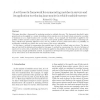Free Online Productivity Tools
i2Speak
i2Symbol
i2OCR
iTex2Img
iWeb2Print
iWeb2Shot
i2Type
iPdf2Split
iPdf2Merge
i2Bopomofo
i2Arabic
i2Style
i2Image
i2PDF
iLatex2Rtf
Sci2ools
EOR
2006
2006
A set theoretic framework for enumerating matches in surveys and its application to reducing inaccuracies in vehicle roadside su
This paper describes a framework for analysing matches in multiple data sets. The framework described is quite general and can be applied to a variety of problems where matches are to be found in data surveyed at a number of locations (or at a single location over a number of days). As an example, the framework is applied to the problem of false matches in licence plate survey data. The specific problem addressed is that of estimating how many vehicles were genuinely sighted at every one of a number of survey points when there is a possibility of accidentally confusing two vehicles due to the nature of the survey undertaken. In this paper, a method for representing the possible types of match is outlined using set theory. The phrase types of match will be defined and formalised in this paper. A method for enumerating Mn, the set of all types of match over n survey sites, is described. The method is applied to the problem of correcting survey data for false matches using a simple proba...
| Added | 12 Dec 2010 |
| Updated | 12 Dec 2010 |
| Type | Journal |
| Year | 2006 |
| Where | EOR |
| Authors | Richard G. Clegg |
Comments (0)

